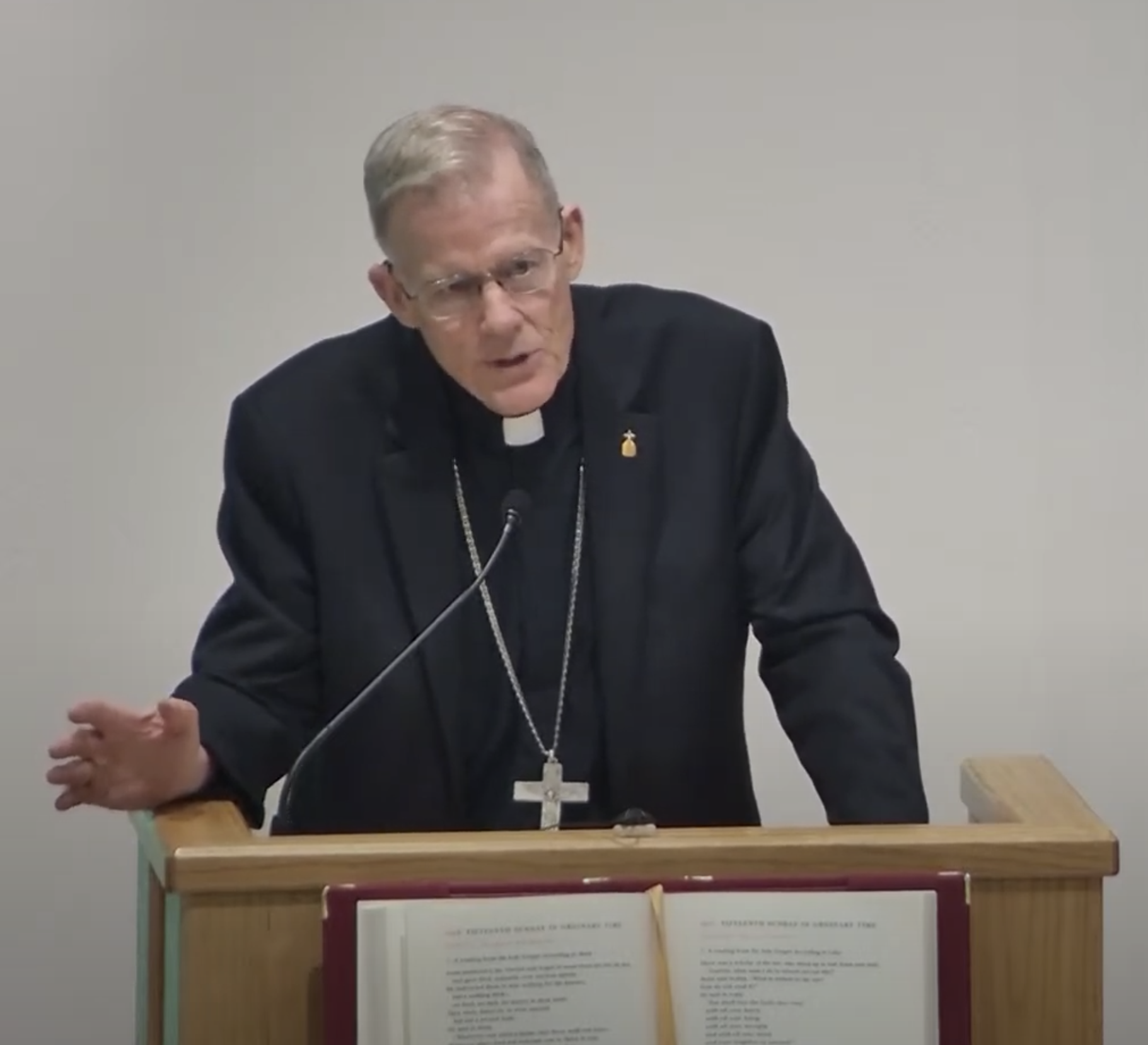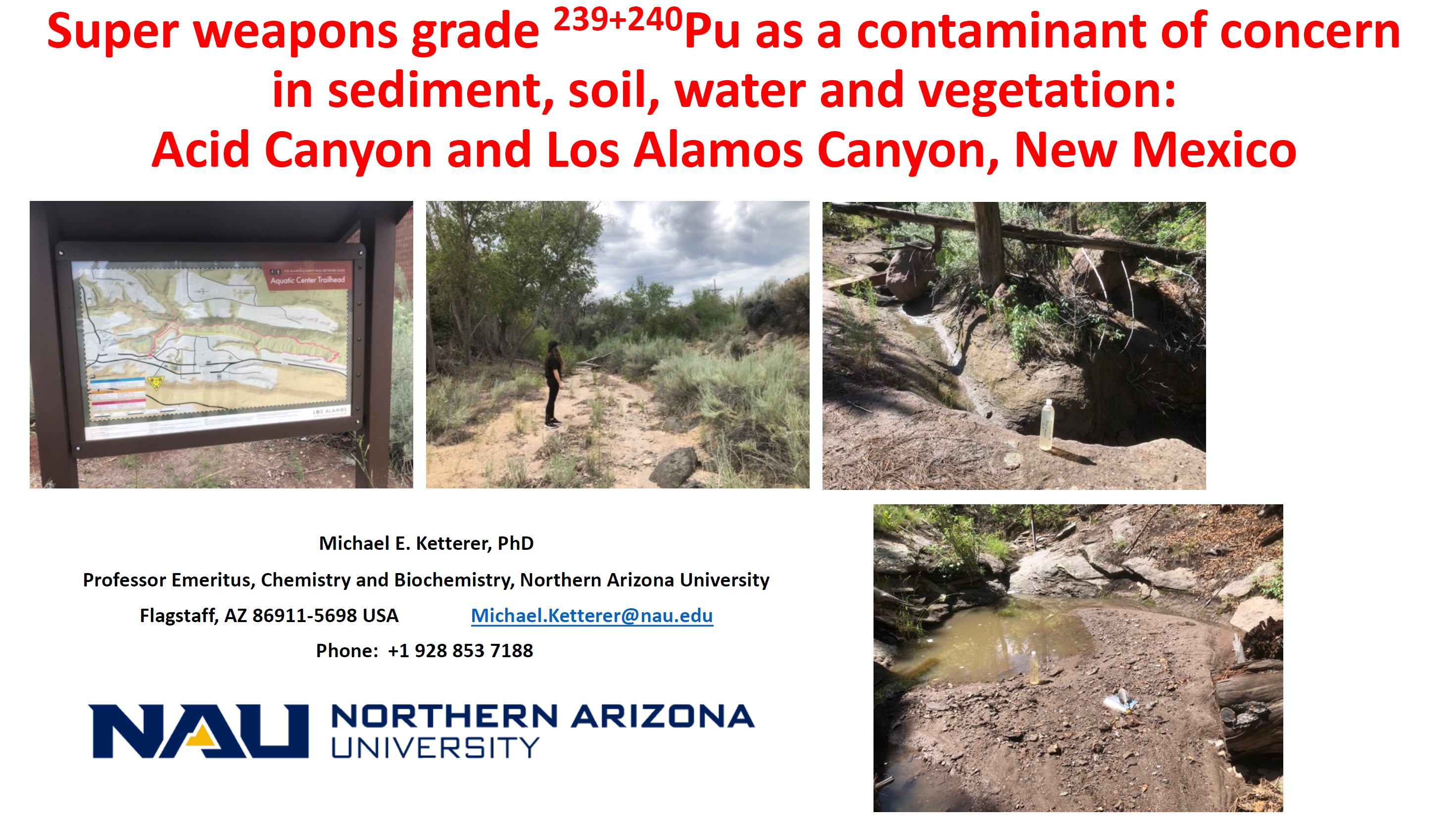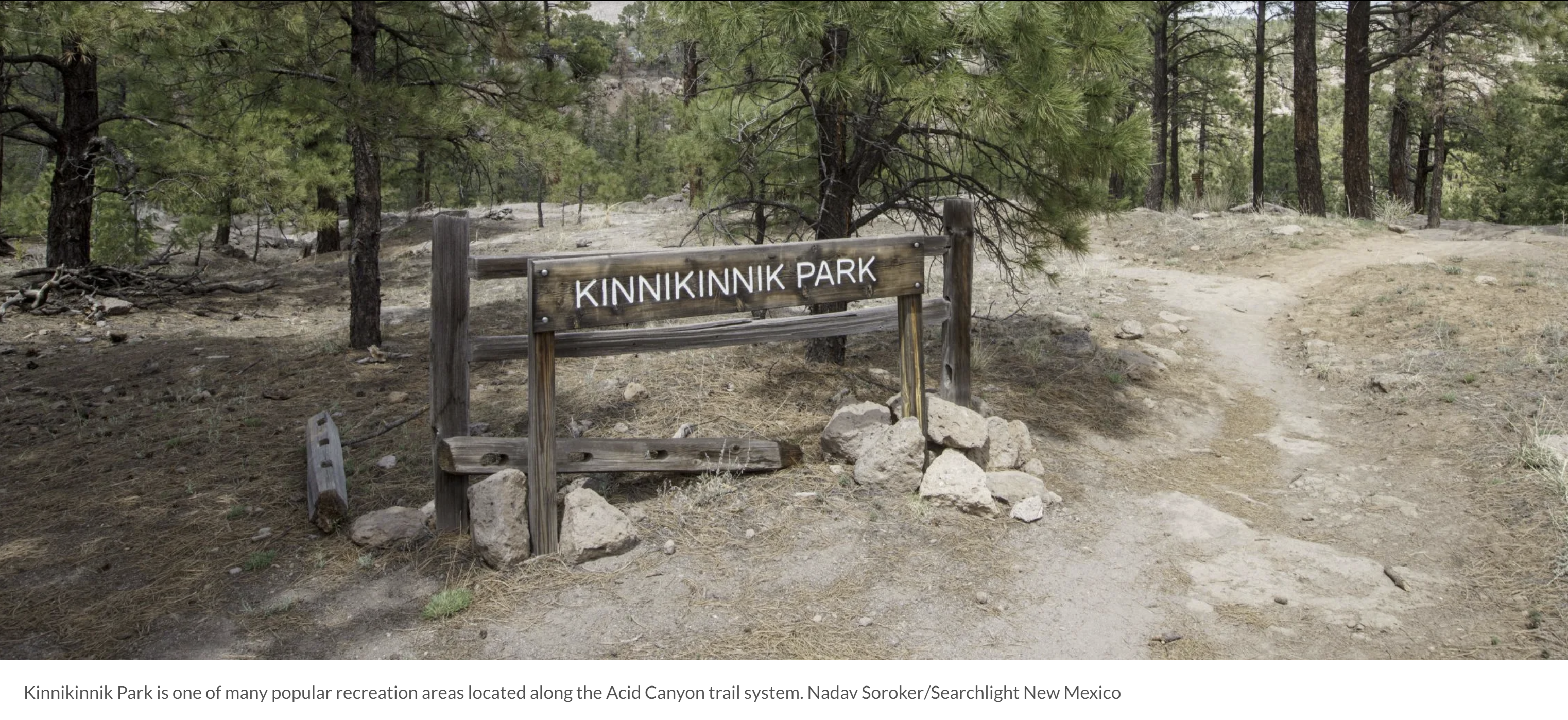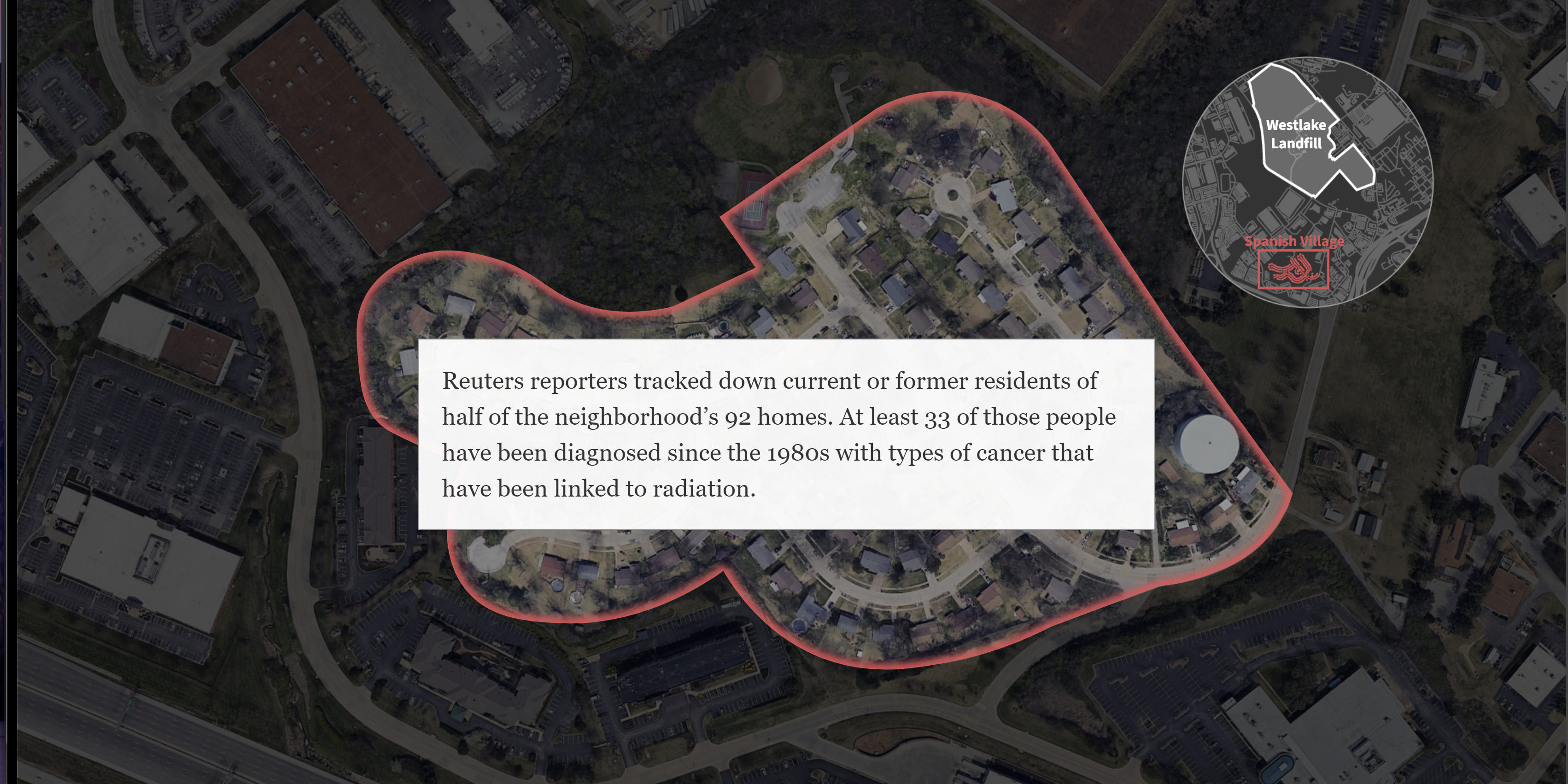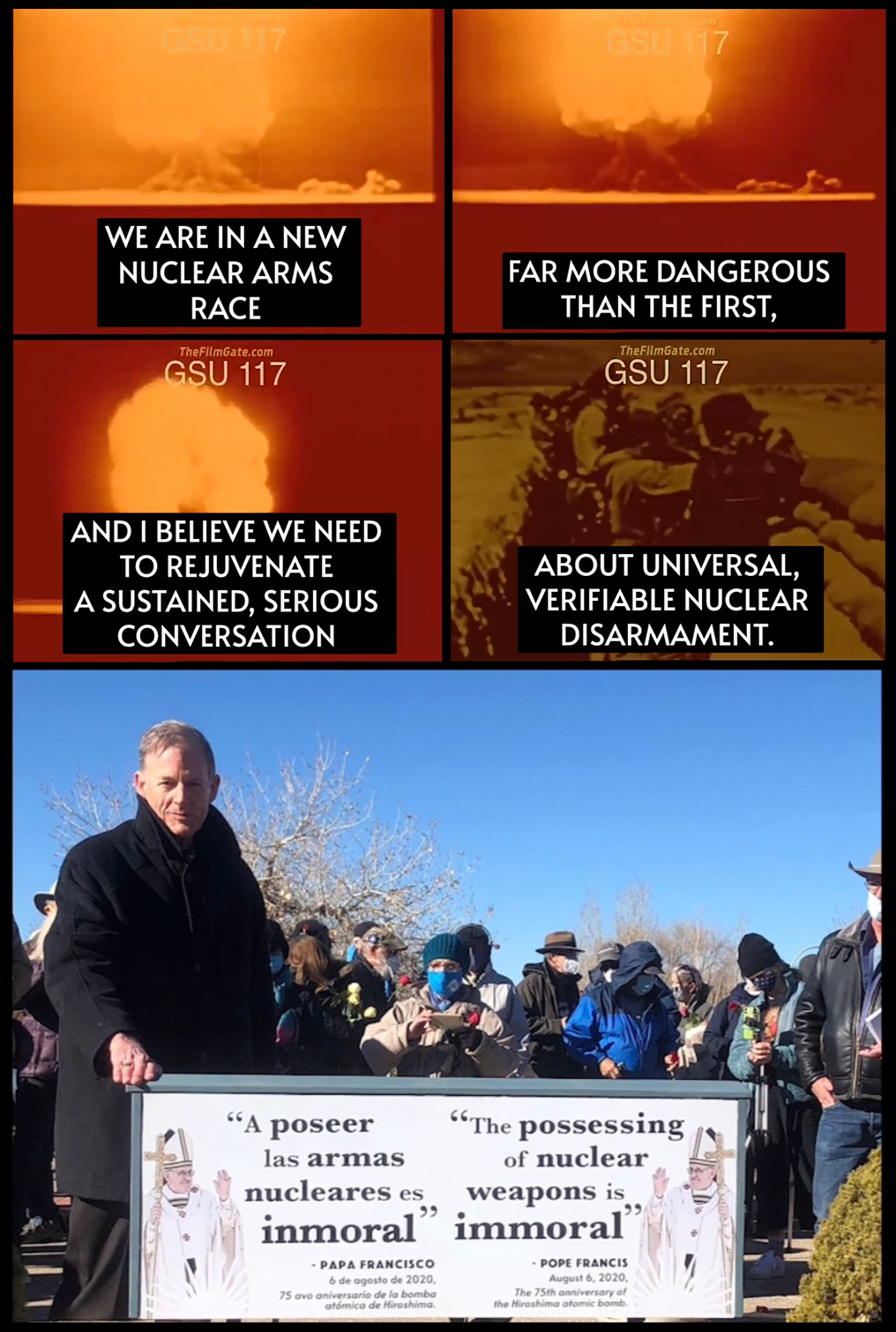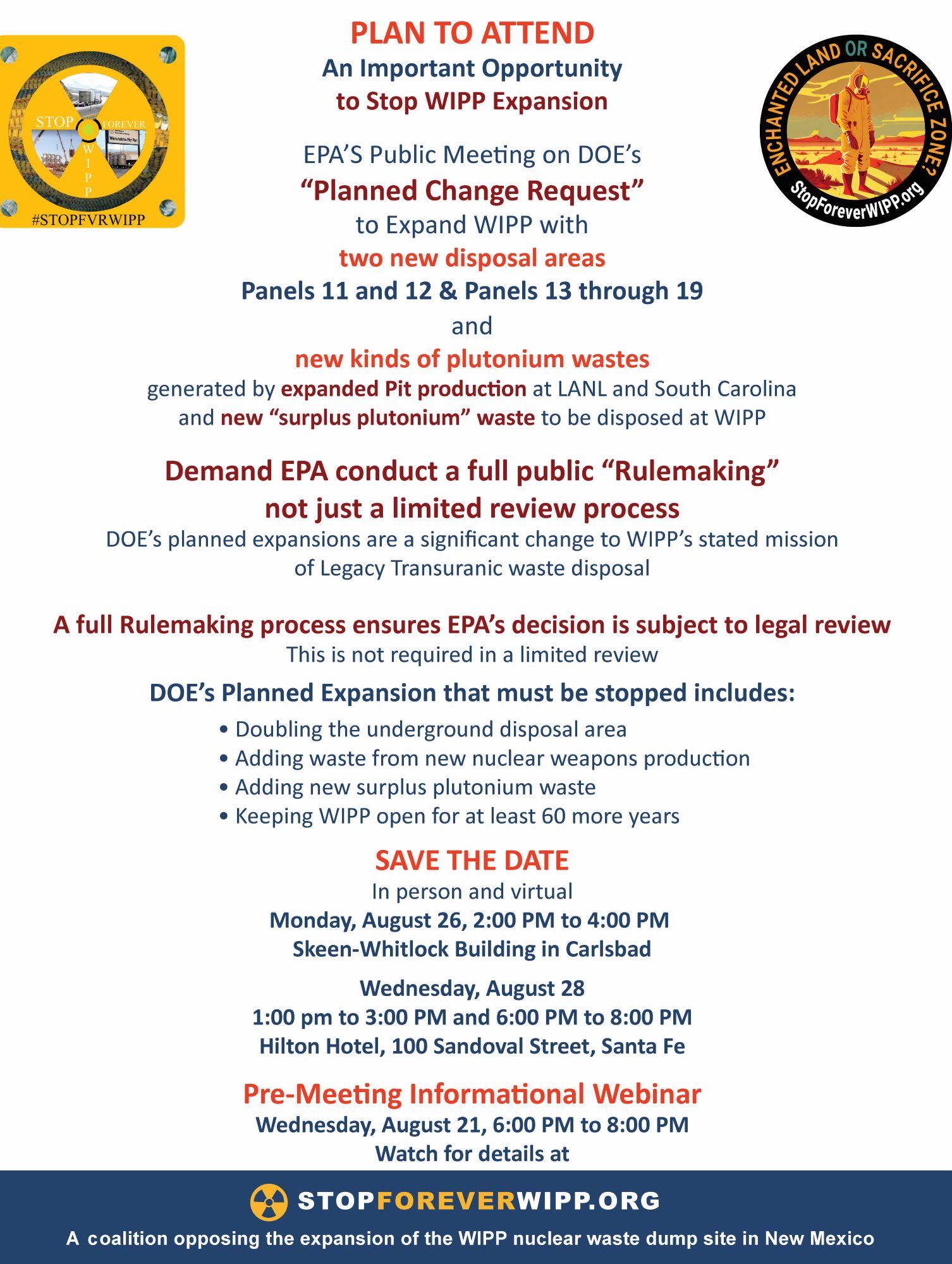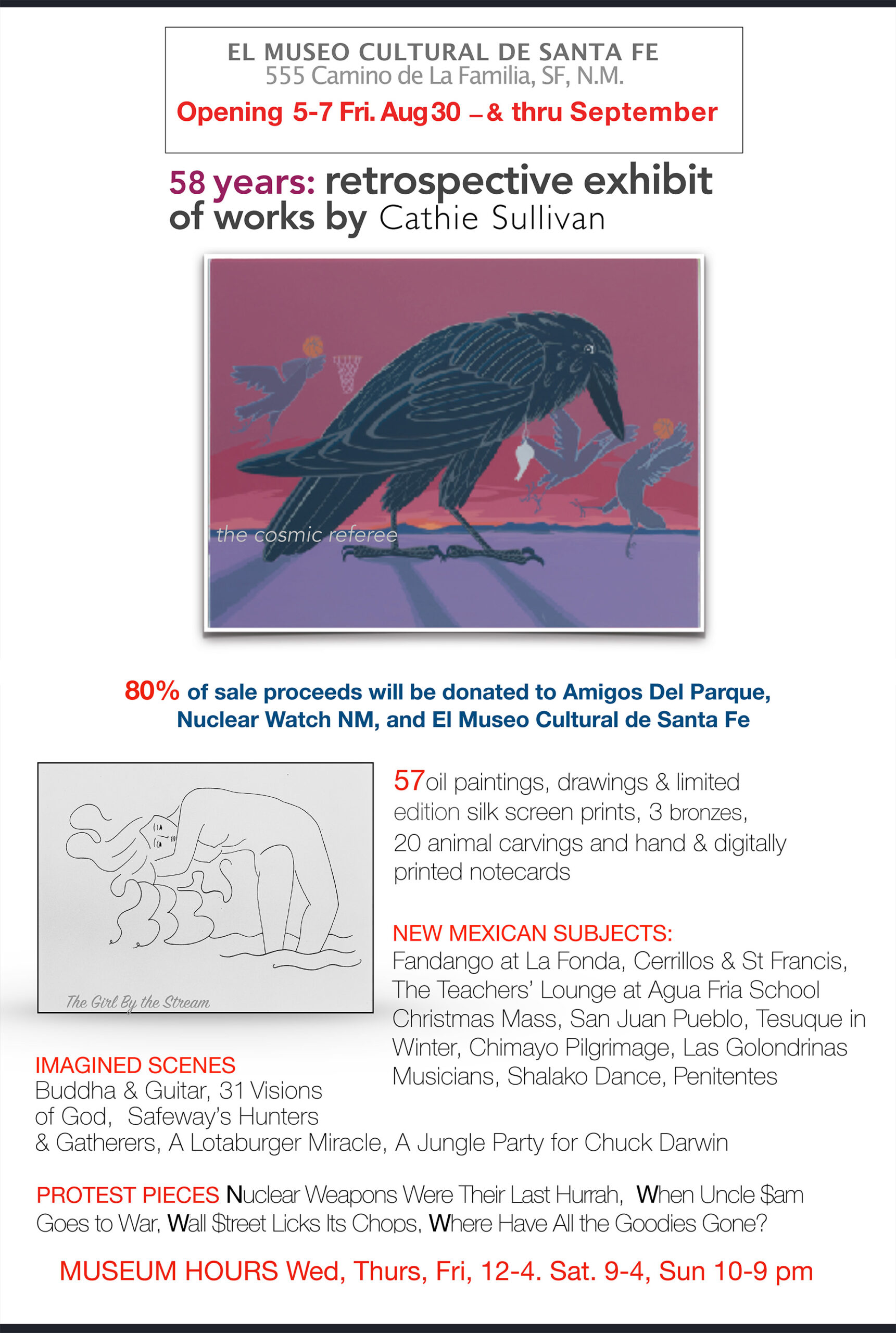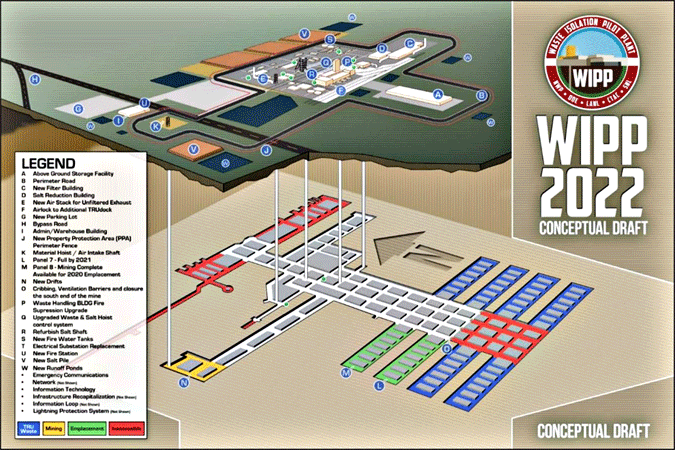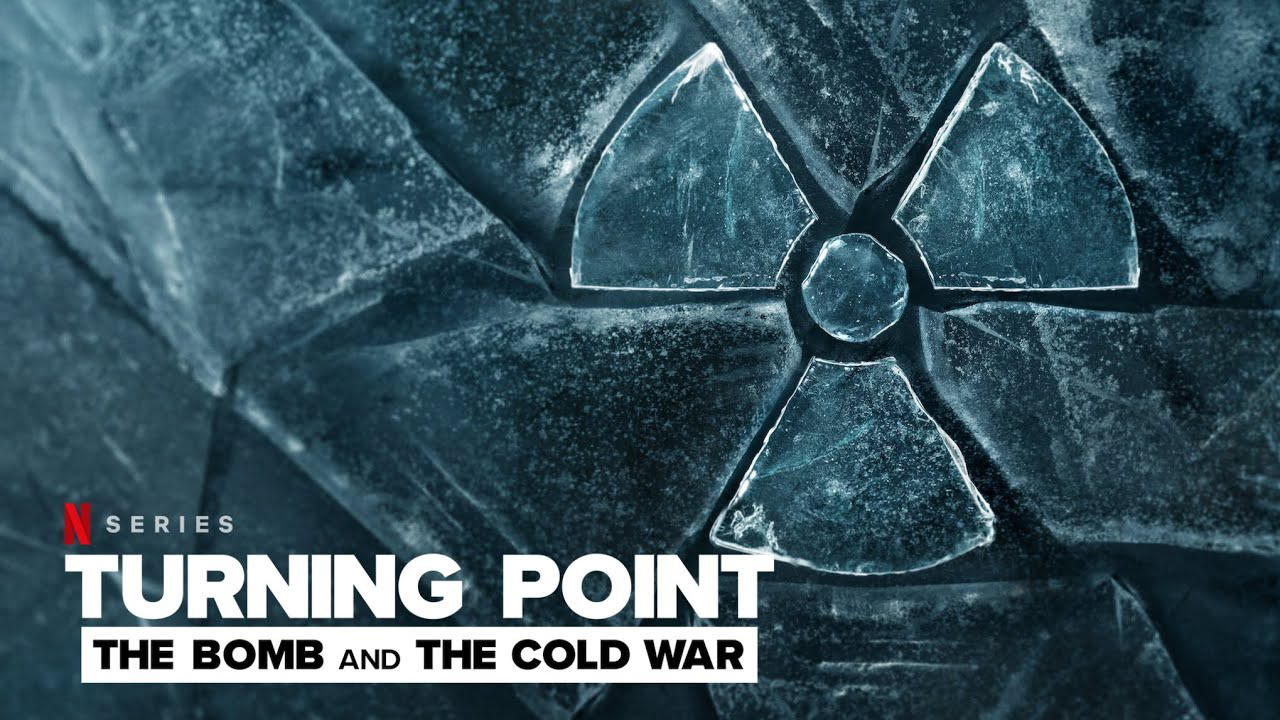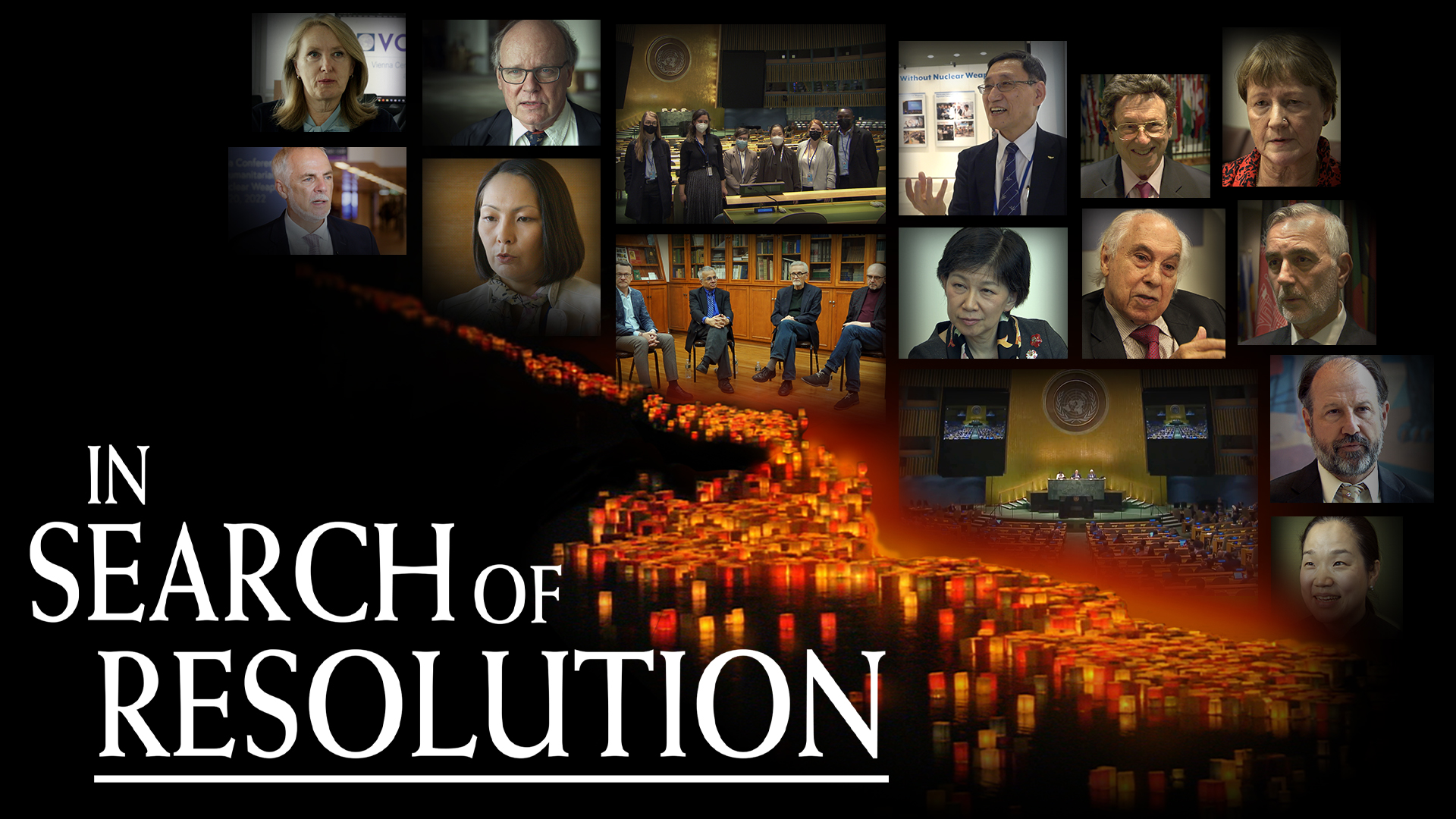QUOTE OF THE WEEK
The Trinity and nuclear bombs have nothing to do with each other
“Oppenheimer called it the Trinity Test [based] on John Donne’s poem, with the Christian reference – but that’s got to be, in my mind, the ultimate oxymoron. The Trinity and nuclear bombs have nothing to do with each other – the Trinity represents life and community, love and tolerance and respect for one another, and atomic weapons are the exact opposite of that.
So we’ve got to do all we can to rid ourselves of this destructive power, and that’s why people of faith are involved in this important matter.”
– Archbishop of Santa Fe, John C. Wester
LANL’s Central Mission: Los Alamos Lab officials have recently claimed that LANL has moved away from primarily nuclear weapons to “national security”, but what truly remains as the Labs central mission? Here’s the answer from one of its own documents:
LANL’s “Central Mission”- Presented at: RPI Nuclear Data 2011 Symposium for Criticality Safety and Reactor Applications (PDF) 4/27/11
Banner displaying “Nuclear Weapons Are Now Illegal” at the entrance in front of the Los Alamos National Lab to celebrate the Entry Into Force of the Nuclear Weapon Ban Treaty on January 22, 2021
“There is nothing comparable in our history to the deceit and the lying that took place as a matter of official Government policy in order to protect this industry. Nothing was going to stop them and they were willing to kill our own people.”
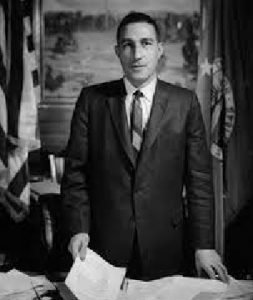
— Stewart Udall, United States Secretary of the Interior under President Kennedy and President Johnson.
He was the father of Senator Tom Udall (who ended up being a vigorous supporter of expanded nuclear weapons “modernization” plans).
Follow the Money!
Map of “Nuclear New Mexico”
In 1985, US President Ronald Reagan and Russian President Mikhail Gorbachev declared that “a nuclear war cannot be won and must never be fought.”

Waste Lands: America’s Forgotten Nuclear Legacy
The Wall St. Journal has compiled a searchable database of contaminated sites across the US. (view)
Related WSJ report: https://www.wsj.com
New & Updated
THE GUARDIAN: Plutonium levels near US atomic site in Los Alamos similar to Chornobyl, study finds
Much of the land near the atomic bomb’s birthplace was converted to recreational areas, but toxic waste remains
By Tom Perkins, The Guardian | August 26, 2024 theguardian.com

Soil, plants and water along popular recreation spots near Los Alamos, New Mexico, the birthplace of the atomic bomb, are contaminated with “extreme concentrations” of plutonium, a new study has found, but calls for the federal government to act have been dismissed.
Michael Ketterer, a Northern Arizona University scientist and lead researcher on the project, said the plutonium levels in and around New Mexico’s Acid Canyon were among the highest he had ever seen in a publicly accessible area in the US during his decades-long career – comparable to what is found in Ukraine at the site of the Chornobyl nuclear disaster.
The radioactive isotopes are “hiding in plain sight”, Ketterer said.
“This is one of the most shocking things I’ve ever stumbled across in my life,” he said.
The paper comes on the heels of the US Department of Defense announcing it will ramp up production of plutonium pits, a core component of nuclear weapons, at Los Alamos. Meanwhile, the US Senate approved a defense bill with expanded funding for those exposed to the government’s radioactive waste. Local public health advocates say they are outraged by the exclusion of the Los Alamos region from the benefits.
Research: Plutonium Levels at Los Alamos Rival Chernobyl’s
Hikers use the New Mexico recreation area without being aware of contamination
By Bob Cronin, Newser Staff, NEWSER | August 26, 2024 newser.com
Los Alamos Researcher Warns of Plutonium in Rec Areas
The federal Atomic Energy Commission turned over New Mexico land around its national laboratory decades ago to Los Alamos County without restricting its use, despite its past as the site where the atomic bomb was developed. Much of it was developed for recreational use. Researchers say there’s a problem: They’ve detected “extreme concentrations” of plutonium in the area, which hikers and others aren’t aware of when they head down a trail, the Guardian reports. “This is one of the most shocking things I’ve ever stumbled across in my life,” said Michael Ketterer of Northern Arizona University, the project’s lead researcher.
Plutonium levels detected around Acid Canyon were among the highest Ketterer said he’s seen in a publicly accessible area in the US, and are comparable to those at the site of the Chernobyl nuclear disaster in Ukraine. People using the trails aren’t in immediate danger, he said, while warning that plutonium can get into water supplies that eventually reach the Rio Grande. It also can enter the food chain through plants or spread widely in ash during a wildfire. The Department of Energy issued a statement saying that the levels were “very low and well within the safe exposure range.” Public health advocates want warning signs to go up for recreational users.
Mapping by a local public health advocacy group, Nuclear Watch New Mexico, that used public records also showed high plutonium levels at sample sites throughout the area, per the Guardian. The research shows “New Mexico will forever be saddled with a radioactive isotope that has a 24,000-year half-life,” said Tina Cordova of the Tularosa Basin Downwinders Consortium advocacy group. Ketterer said cleanup—removing the contamination—isn’t practical, per the AP. “It really can’t be undone,” he said.Canyon.
People Harmed by Radiation Exposure Can Forget About Any Federal Compensation
Speaker Mike Johnson killed a proposal to provide benefits to victims of America’s nuclear program.
“It’s really tough to have people say, ‘Nope, sorry that’s too expensive. It wasn’t too expensive to poison you, but it’s too expensive to fix what we did and you aren’t worth it.'”
By Katherine Hapgood, Mother Jones | August 21, 2024 motherjones.com

It wasn’t a difficult choice for Linda Evers, after graduating high school in 1976, to take a job crushing dirt for the Kerr McGee uranium mill, just north of her hometown Grants, New Mexico. Most gigs in town paid $1.75 an hour. This one offered $9 an hour.
She spent seven years working in New Mexico’s uranium mines and mills, driving a truck and loading the ore crusher for much of the late 1970s and early ’80s, including through her pregnancies with each of her children. “When I told them I was pregnant,” Evers, now 66, recalled, “they told me it was okay, I could work until my belly wouldn’t let me reach the conveyor belts anymore.”
Both children were born with health defects—her son with a muscle wrapped around the bottom of his stomach and her daughter without hips. Today, Evers herself suffers from scarring lungs, a degenerative bone and joint disease, and multiple skin rashes. All of which doctors have attributed to radiation exposure.
“We never learned about uranium exposure or any of that. They were killing us. And they knew they were killing us.”
High Detections of Plutonium in Los Alamos’ Acid Canyon
High Detections of Plutonium in Los Alamos Neighborhood – As We Enter a New Nuclear Arms Race the Last One is Still Not Cleaned Up
FOR IMMEDIATE RELEASE, August 15, 2024
Dr. Michael Ketterer – 928.853.7188 | Email
Jay Coghlan – 505.989.7342 | Email
Santa Fe, NM – In April Nuclear Watch New Mexico released a map of plutonium contamination based on Lab data. Today, Dr. Michael Ketterer, Professor Emeritus of Chemistry and Biochemistry, Northern Arizona University, is releasing alarmingly high results from samples taken from a popular walking trail in the Los Alamos Town Site, including detections of some of the earliest plutonium produced by humankind.
On July 2 and 17 Dr. Ketterer, with the assistance of Nuclear Watch New Mexico, collected water, soil and plant samples from Acid Canyon in the Los Alamos Town Site and soil and plant samples in Los Alamos Canyon at the Totavi gas station downstream from the Lab. The samples were prepared and analyzed by mass spectrometry at Northern Arizona University to measure concentrations of plutonium, and to ascertain its sources in the environment. For water samples, concentration is expressed in picocuries1 per liter (pCi/L) and for soil and plants in picocuries per gram (pCi/g). The provenance of the plutonium was determined through isotopic examination of the ratio of 239Pu atoms to 240Pu atoms, which distinguishes it from global nuclear weapons testing fallout.
Acid Canyon is located in the heart of the Los Alamos Town Site, contiguous to the busy Aquatic Center which also has the trailhead for the popular walk into the Canyon. From 1943 to 1963 radioactive liquid wastes were disposed by piping them over the Canyon wall (plutonium is often processed with nitric acid, hence the Canyon’s name). Acid Canyon ultimately drains via the Los Alamos Canyon through San Ildefonso Pueblo lands to the Rio Grande. Earlier studies have identified Lab plutonium as far as 17 miles south in Cochiti Lake.
Scientist says there’s legacy plutonium contamination in Los Alamos
‘Extreme plutonium contamination scenario’ identified in research from , soil, water and plant samples taken in Acid Canyon arroyos
BY DANIELLE PROKOP, SOURCE NM | August 16, 2024 sourcenm.com
 Los Alamos, the Atomic City, is facing a legacy of its nickname.
Los Alamos, the Atomic City, is facing a legacy of its nickname.
High levels of plutonium present in samples taken in July from soil, plants and water in Los Alamos’ Acid Canyon may be the oldest contamination in the state, predating the 1945 Trinity Site atomic test, said Michael Ketterer, an analytical chemist and retired professor of chemistry from Northern Arizona University.
“There are some references to contamination being introduced into Acid Canyon starting in 1943,” he said Thursday. “It is very logical to me that this is some of the earliest produced material.”
The legacy plutonium contamination estimated to have lasted into the 1960s is still impacting the land, water and potentially human health, he said in a presentation hosted by Nuclear Watch NM.
“What I’ve found here in Acid Canyon, my friends, is I’d say pretty much the most extreme plutonium contamination scenario I’ve seen in an offsite, uncontrolled environmental setting,” Ketterer said, alluding to thousands of plutonium samples he’s analyzed in his 20-year career.
He said that contamination levels surpass samples he took at private properties around the former plutonium pit production site in Rocky Flats, Colorado.
One concern, which he said warrants immediate federal or state environment protection intervention, was the levels of plutonium contamination in water flows in Acid Canyon.
Scientist describe levels of plutonium near Los Alamos ‘alarmingly high’
By: Chandler Farnsworth, KRQE | August 15, 2024 krqe.com
LOS ALAMOS, N.M. (KRQE) – New findings from a study aimed at researching how much plutonium is in the ground and water near Los Alamos National Laboratory, have the lead scientists concerned.
“I’m just trying to show New Mexicans what the truth is here,” said Dr. Michael Ketterer, Professor Emeritus of Chemistry and Biochemistry at Northern Arizona University. Over the last few months, Dr. Ketterer has collected and analyzed plutonium levels from a trailhead at Acid Canyon in Los Alamos, NM.
“I see a lot of things to be concerned about here,” Dr. Ketterer said.
In his study, Dr. Ketterer says he found “alarmingly high results” of plutonium contamination. Though radiation levels are not high enough to hurt people walking the trail, advocates with Nuclear Watch New Mexico worry about what could happen if a fire broke out, warning that the smoke inhaled could lead to lung cancer.
“Were Acid Canyon to burn in a wildfire, and we know that threat is all too real, that could be dangerous in the form of respirable plutonium that is released to the air through wildfire,” said Jay Coghlan, Executive Director for Nuclear Watch New Mexico.
“We can’t really predict where it’s going to go and how bad it’s going to be,” added Dr. Ketterer about the possibility of a fire happening in the area.
Copyright 2024 Nexstar Media Inc
Watchdog group reports ‘extreme contamination’ of plutonium at Los Alamos open space
The legacy of environmental waste is “hiding in plain sight” at a popular open space in the heart of Los Alamos that became a dumping ground during the Manhattan Project, according to testing results a nuclear watchdog group released Thursday.
By Daniel J. Chacón [email protected], Santa Fe New Mexican | August 15, 2024 santafenewmexican.com
Soil, plant and water samples collected in July from Acid Canyon — yes, Acid Canyon — revealed “extreme contamination,” including detections of what Nuclear Watch New Mexico said is some of the earliest plutonium produced by humankind.
“What I found here in Acid Canyon [is] pretty much the most extreme contamination scenario I’ve seen in an off-site, uncontrolled environmental setting,” Michael Ketterer, a professor emeritus of chemistry and biochemistry at Northern Arizona University, said during a virtual briefing.
Ketterer, who collected the samples in July with the help of the watchdog group, said he’s analyzed tens of thousands of plutonium samples in a decadeslong career.
“This is way, way, way, way, way at the top end of the charts in terms of how much,” he said. “This is extreme contamination.”
Ketterer said he would compare it to “Chernobyl proximity samples” and samples close to Palomares, Spain, after a B-52 bomber carrying hydrogen bombs collided with a refueling plane in 1966 and coated the seaside town in radioactive dust.
“Hundreds of samples from near Rocky Flats do not come close at all,” he said, referring to a former nuclear weapons production facility in Colorado.
Watchdogs want US to address extreme plutonium contamination in Los Alamos’ Acid Canyon
“This is an unrestricted area. I’ve never seen anything quite like it in the United States,” the professor told reporters. “It’s just an extreme example of very high concentrations of plutonium in soils and sediments. Really, you know, it’s hiding in plain sight.”
Ketterer teamed up with the group Nuclear Watch New Mexico to gather the samples in July, a rainy period that often results in isolated downpours and stormwater runoff coursing through canyons and otherwise dry arroyos. Water was flowing through Acid Canyon when the samples were taken.
BY SUSAN MONTOYA BRYAN, ASSOCIATED PRESS | August 15, 2024 apnews.com
ALBUQUERQUE, N.M. (AP) — Watchdogs are raising new concerns about legacy contamination in Los Alamos, the birthplace of the atomic bomb and home to a renewed effort to manufacture key components for nuclear weapons.
A Northern Arizona University professor emeritus who analyzed soil, water and vegetation samples taken along a popular hiking and biking trail in Acid Canyon said Thursday that there were more extreme concentrations of plutonium found there than at other publicly accessible sites he has researched in his decades-long career.
That includes land around the federal government’s former weapons plant at Rocky Flats in Colorado.
While outdoor enthusiasts might not be in immediate danger while traveling through the pine tree-lined canyon, Michael Ketterer — who specializes in tracking the chemical fingerprints of radioactive materials — said state and local officials should be warning people to avoid coming in contact with water in Acid Canyon.
A nuclear legacy in Los Alamos
After three cleanups, independent analysis shows 80-year-old plutonium persists in Acid Canyon and beyond
By Alicia Inez Guzmán, Searchlight New Mexico | August 15, 2024 searchlightnm.org
The world’s oldest documented plutonium contamination may not lie not in the Chihuahuan Desert at the Trinity Site, where the first-ever atomic bomb ripped open the skies and melted the sand into green glass. Rather, that distinction more likely goes to Los Alamos’s Acid Canyon, according to an independent study by Michael Ketterer, professor emeritus of chemistry and biochemistry at Northern Arizona University.
Ketterer announced these findings at an online press conference held by Nuclear Watch New Mexico on Aug. 15, after collecting and analyzing soil, water and plant samples in Acid Canyon, a popular hiking area in the middle of town. Beginning in 1943, the year the Manhattan Project came to Los Alamos, workers released radioactive waste into the canyon. Three remediations would follow, but as Ketterer’s analysis found, “a super weapons-grade” plutonium persists in the soil, water and plant life in and around Los Alamos, representing some of the earliest ever made.
One thought came to his mind as he analyzed samples from the area, collected last month:
“I’ve never seen anything like this in any samples anywhere,” he told Searchlight New Mexico in an interview.
How a US health agency became a shield for polluters
Companies and others responsible for some of America’s most toxic waste sites are using a federal health agency’s faulty reports to save money on cleanups, defend against lawsuits and deny victims compensation, a Reuters investigation found. A Missouri neighborhood’s tale.
By JAIMI DOWDELL, M.B. PELL, BENJAMIN LESSER, MICHELLE CONLIN, PHOEBE QUINTON and WAYLON CUNNINGHAM, Reuters | August 11, 2024 reuters.com
When they bought their homes in the Spanish Village neighborhood northwest of St. Louis, many residents had no idea a radioactive landfill sat less than a mile away.
Health conditions mounted over the years, suggesting something wasn’t right.
Wester warns: ‘We are now in a nuclear arms race far more dangerous than the first’
“…There is a frustration that our world leaders are not listening. The tragedy of the 200,000 killed both in Hiroshima and Nagasaki seems to fall on deaf ears.
We are now in a nuclear arms race arguably far more dangerous than the first. We see countries modernizing their nuclear arsenals and spending scads of money in what appears to be (a move toward) ‘nuclear weapons forever.’”
By Gina Christian, OSV News | August 6, 2024 catholicreview.org
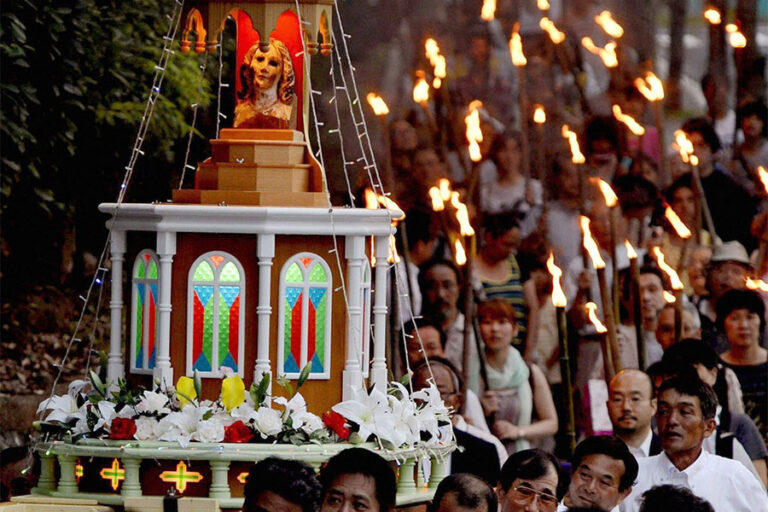
Archbishop John C. Wester of Santa Fe, N.M., has traveled to Japan on a “pilgrimage of peace” commemorating the 79th anniversary of the atomic bombings of Hiroshima and Nagasaki during World War II. The pilgrimage, which the archbishop undertook last year as well, was announced Aug. 3 by the Santa Fe Archdiocese.
The attacks on the two Japanese cities — launched by the U.S. on Aug. 6 and 9, 1945, in an effort to force the unconditional surrender of Japan and hasten the end of the war — killed an estimated 110,000 to 210,000 people. The true number of casualties is “probably fundamentally unknowable,” according to nuclear weapons historian Alex Wellerstein.
Continue reading
Thank You For All Your Support
We are living in the most dangerous times since the 1980’s. The world is in a new nuclear arms race, arguably more dangerous than the last because there are now multiple nuclear actors, new cyber and hypersonic weapons and artificial intelligence.
CRITICAL EVENTS
UPCOMING: Groundbreaking Forum on Nuclear Weapons – 1:45 p.m. to 5 p.m. Saturday, Sept. 7, 2024
Hosted by the Institute for Advanced Catholic Studies at the University of Southern California and the University of New Mexico
Considered the first of its kind since the 1980s, the forum will feature prominent policymakers and thought leaders discussing approaches to nuclear disarmament and deterrence
ALBUQUERQUE – Tuesday, August 13, 2024 – IMMEDIATE RELEASE — A groundbreaking discussion in September at the University of New Mexico will feature high-ranking public policy experts, influential spiritual leaders, and prominent academics exploring strategic and ethical responses to one of the most urgent issues facing humanity: the rising threat of nuclear war.
“Forum on Nuclear Strategy: Disarmament & Deterrence in a Dangerous World” will be held from 1:45 p.m. to 5 p.m. (MDT) on Saturday, Sept. 7, 2024 in the university’s Student Union Building Ballroom A. Considered the first of its kind since the American Catholic bishops reshaped the nuclear weapons debate in the 1980s, the forum is led by the Institute for Advanced Catholic Studies at the University of Southern California, the Endowed Chair of Roman Catholic Studies at the University of New Mexico, and UNM’s Religious Studies Program.
“The forum is an important opportunity for experts in religious and secular fields to learn from each other as they explore modern nuclear strategy decisions,” said Most Rev. John C. Wester, Archbishop of Sante Fe, whose 2022 pastoral letter Living in the Light of Christ’s Peace: A Conversation Toward Nuclear Disarmament calls for dynamic discussion on nuclear disarmament. “It’s precisely these conversations that will lead to a clearer understanding of the threat that nuclear weapons pose and how best to navigate the waters of the perilous arms race we find ourselves in today.”
Tell EPA: Stop Proposed WIPP Expansion
In late August You have an Important Opportunity to Stop WIPP Expansion
Plan to attend and participate in EPA’s Public Meetings on DOE’s “Planned Change Request” to expand WIPP
The meetings are virtual and in-person Monday, August 26 in Carlsbad Wednesday, August 28 in Santa Fe
EPA needs your comments
Endless Nuclear Waste Storage in NM?? Not On Our Watch…
Keep up with the Stop Forever WIPP Coalition to learn how to take action against the Federal Government’s Plan to Expand WIPP and keep it open indefinitely.
Visit the Stop Forever WIPP Coalition’s website and social media:
Website: www.StopForeverWIPP.org
Facebook: facebook.com/StopfvrWIPP
Twitter: twitter.com/stopforeverwipp
Instagram: instagram.com/stopfvrwipp
Stay Informed of All Permit-Related Happenings at WIPP! Sign Up for Updates:
The New Mexico Environment Department maintains a Facility Mailing List to which you can add your name and address to get the latest information – just email Ricardo Maestas at the New Mexico Environment Department at [email protected] and ask to be added to the list. Or mail your request with your mailing address to:
Continue reading
New Nuclear Media: Art, Films, Books & More
“Turning Point: The Bomb and the Cold War” Explores Impact of US–Soviet Conflict
The nine-part doc examines how two global superpowers have irrevocably altered the course of history.
By Roxanne Fequiere, Netflix | netflix.com
While the the Cold War ended in 1991, even a casual appraisal of current headlines reveals that relations between the United States and Russia — the one-time center of the Soviet Union — remain tense, to say the least. The global repercussions of the Cold War continue to ripple through the current geopolitical landscape to this day, but it can be difficult to understand just how a mid-20th century struggle for ideological dominance continues to ensnare countless nations in ongoing unrest.
Turning Point: The Bomb and the Cold War, a nine-part documentary series from director Brian Knappenberger, provides a comprehensive appraisal of the events that led to the Cold War and traces the conflict around the world and through the decades.
Continue reading
In Search of Resolution: New Documentary on Nuclear Dangers
The new documentary “In Search of Resolution,” examines the current state of international nuclear arms control and is the third film of The Nuclear World Project.
Filmed in 2022 after the Russian invasion of Ukraine, this timely documentary examines the continuing dangers posed by the existence of nuclear weapons. The program includes in-depth interviews with scholars, ambassadors, and leaders in the field to provide historical context, while international experts reflect on arms control measures, nuclear disarmament, and possible ways forward.
The film provides, among other things, an interesting inside look at the TPNW MSP1, the 2022 Conference on the Humanitarian Impacts of Nuclear Weapons, and the 2022 NPT Review Conference.
Find out more and watch online here: https://video.kpbs.org/show/in-search-of-resolution/



